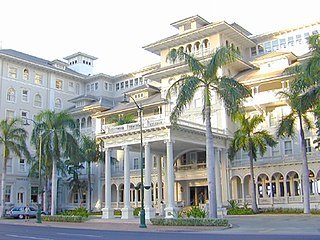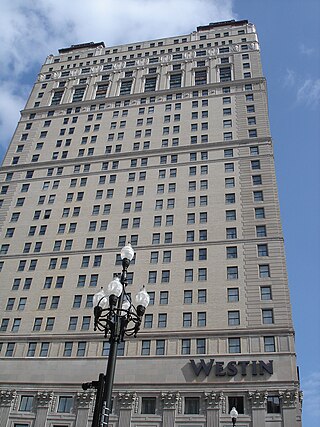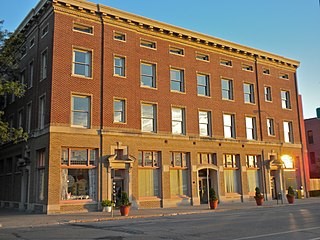
The Moana Hotel is a historic hotel building in Honolulu, Hawaii, located at 2365 Kalākaua Avenue in the Waikiki neighborhood. Built in the late 19th century as the first hotel in Waikiki, the Moana opened in 1901. It is listed on the National Register of Historic Places. The hotel was also inducted into Historic Hotels of America, the official program of the National Trust for Historic Preservation, in 1989. The building is currently part of the resort complex known as Moana Surfrider, A Westin Resort & Spa and is managed by Westin Hotels & Resorts.

The Mayflower Hotel is a historic hotel in downtown Washington, D.C., located on Connecticut Avenue NW. It is two blocks north of Farragut Square. The hotel is managed by the Autograph Collection Hotels division of Marriott International. The Mayflower is the largest luxury hotel in the District of Columbia, the longest continuously operating hotel in the Washington D.C. area, and a rival of the nearby Willard InterContinental and Hay-Adams Hotels. The Mayflower is known as the "Grande Dame of Washington", the "Hotel of Presidents", and as the city's "Second Best Address" —the latter sobriquet attributed to President Harry S. Truman. It was also a charter member of Historic Hotels of America, the official program of the National Trust for Historic Preservation. Today it is a four-star hotel.

The Fairmont Empress, formerly and commonly referred to as The Empress, is one of the oldest hotels in Victoria, British Columbia, Canada. Located on 721 Government Street, it is situated in Downtown Victoria, facing the city's Inner Harbour. The hotel was designed by Francis Rattenbury, and was built by Canadian Pacific Hotels, a division of the Canadian Pacific Railway company. The hotel is presently managed by Fairmont Hotels and Resorts, part of AccorHotels since 2016. It is owned by Nat and Flora Bosa of Vancouver.

The Blackstone Hotel is a historic 290-foot (88 m) 21-story hotel on the corner of Michigan Avenue and Balbo Drive in the Michigan Boulevard Historic District in the Loop community area of Chicago, Illinois. Built between 1908 and 1910, it is on the National Register of Historic Places. The Blackstone is famous for hosting celebrity guests, including numerous U.S. presidents, for which it was known as the "Hotel of Presidents" for much of the 20th century, and for contributing the term "smoke-filled room" to political parlance.

The Driskill, a Romanesque-style building completed in 1886, is the oldest operating hotel in Austin, Texas, United States, and one of the best-known hotels in Texas generally. The Driskill was conceived and built by Col. Jesse Driskill, a cattleman who spent his fortune constructing "the finest hotel south of St. Louis".

The Davenport Hotel is a hotel located in Spokane, Washington. Originally a successful high-end restaurant, it is one of the possible places where the first Crab Louis was created and served. The hotel was designed by architect Kirtland Cutter and built in 1914 for $2 million with an opulent lobby and new amenities for the time such as air conditioning, a central vacuum system, pipe organ, and dividing doors in the ballrooms. Commissioned by a group of Spokane businessmen to have a place to host and entertain their guests, the hotel is named after Louis Davenport, an influential businessman and the first proprietor and overseer of the project.

The Peabody Memphis is a historic luxury hotel in Downtown Memphis, Tennessee, opened in 1925. The hotel is known for the "Peabody Ducks" that live on the hotel rooftop and make daily treks to the lobby. The Peabody is a member of Historic Hotels of America, a program of the National Trust for Historic Preservation.

The Palace Hotel is a landmark historic hotel in San Francisco, California, located at the southwest corner of Market and New Montgomery streets. The hotel is also referred to as the New Palace Hotel to distinguish it from the original 1875 Palace Hotel, which had been demolished after being gutted by the fire caused by the 1906 San Francisco earthquake.

The Westin Book Cadillac Detroit is a historic skyscraper hotel in downtown Detroit, Michigan, within the Washington Boulevard Historic District. Designed in the Neo-Renaissance style, and opened as the Book-Cadillac Hotel in 1924, the 349 ft (106 m), 31-story, 453-room hotel includes 65 exclusive luxury condominiums and penthouses on the top eight floors. It reopened in October 2008, managed by Westin Hotels, after a $200-million restoration.

The Roosevelt New Orleans in New Orleans, Louisiana, is a 504-room hotel owned by AVR Realty Company and Dimension Development and managed by Waldorf Astoria Hotels & Resorts. The hotel was originally built by Louis Grunewald, a German immigrant, and opened in 1893 as "The Hotel Grunewald."

InterContinental Chicago Magnificent Mile is a hotel in Chicago, United States. The hotel currently occupies two multi-story buildings. The historic tower, or "South Tower," is a 471-foot (144 m), 42-story building which was completed in 1929 originally as the home of the Medinah Athletic Club. The new tower, or "North Tower" is a 295-foot (90 m), 26-story addition, completed in 1961.

Les Cours Mont-Royal is an upscale shopping mall in the city's downtown core of Montreal, Quebec, Canada, which was converted from the former Mount Royal Hotel.

Bathhouse Row is a collection of bathhouses, associated buildings, and gardens located at Hot Springs National Park in the city of Hot Springs, Arkansas. The bathhouses were included in 1832 when the Federal Government took over four parcels of land to preserve 47 natural hot springs, their mineral waters which lack the sulphur odor of most hot springs, and their area of origin on the lower slopes of Hot Springs Mountain.

The RSA Trustmark Building, originally the First National Bank Building, is a 34 story, 424-foot (129 m) International Style office tower located in downtown Mobile, Alabama. Most recently known as the AmSouth Bank Building, it had been named in honor of its largest tenant until 2006, AmSouth Bancorporation. It was renamed the GM Building by its new owner, Retirement Systems of Alabama, in 2009. Following a lease agreement with BancTrust Financial Group and its community bank subsidiary, BankTrust, it was renamed again, this time to the RSA–BankTrust Building. BancTrust Financial Group was purchased in 2013 by Trustmark Corporation, a Mississippi based financial institution. The building officially became the RSA Trustmark Building. Trustmark occupies 72,000 square feet (6,700 m2) of the tower, including the lobby floor and floors 25 through 31.

The Federal Building and U.S. Post Office, Spokane, Washington is a historic post office, courthouse, and custom house building at Spokane in Spokane County, Washington. It is a courthouse for the United States District Court for the Eastern District of Washington.

The Seelbach Hilton Louisville is a historic hotel in Louisville, Kentucky. Founded by Bavarian-born immigrant brothers Louis and Otto Seelbach, it opened in 1905 as The Seelbach Hotel and is designed in the French Renaissance style. The hotel has hosted numerous celebrities, including F. Scott Fitzgerald, who took inspiration from the Seelbach for a hotel in The Great Gatsby. The hotel is part of the Hilton Hotels & Resorts chain.

The St. Regis Washington, D.C. known for many years as the Carlton Hotel, is an historic hotel located at 923 16th and K streets, N.W. in Washington, D.C. two blocks north of the White House.

The Northwestern Hotel is an historic building located in the East Village of Des Moines, Iowa, United States. It was listed on the National Register of Historic Places in 1984. In 2017 it was included as a contributing property in the East Des Moines Industrial Historic District.

The Renaissance Cleveland Hotel is a historic hotel on Public Square in Cleveland, Ohio, opened in 1918 as the Hotel Cleveland. It is today part of the Tower City Center mixed-use complex.

The Admiral Hotel is a historic hotel located in downtown Mobile, Alabama.
























